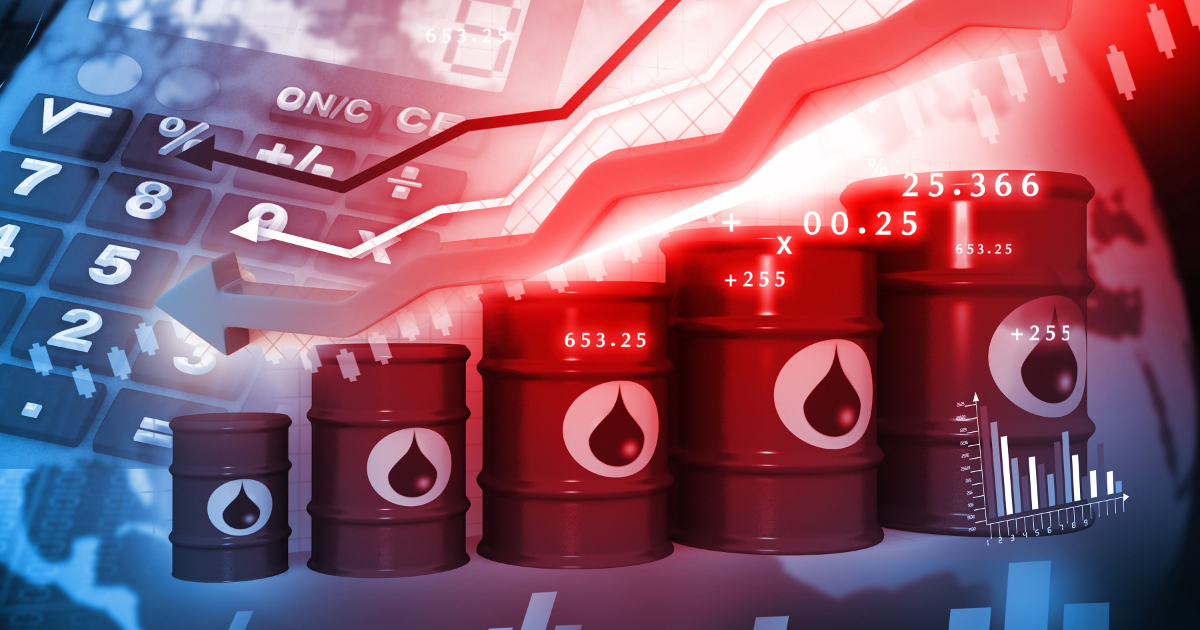
The enduring risk of heightened conflict and political unrest in the Middle East, underscored by missile interceptions and regional tensions, could escalate global oil prices.
Therefore, it could be prudent to invest in robust energy stocks Marathon Petroleum Corporation (MPC), Valero Energy Corporation (VLO), and Cheniere Energy, Inc. (LNG), which seem well-positioned to capitalize on any potential spike in oil prices.
The Israel-Hamas conflict exacerbates amid the ongoing Russian-Ukrainian conflict, already placing a strain on global markets. This has become the most significant shock in commodity markets since the 1970s. The World Bank anticipates this could trigger oil price surges should the unrest magnify across the Middle East.
In the monthly Reuters survey, analysts cautioned that an intensified escalation in the conflict could spill over across the Middle East, pose a risk to supply chains, and potentially cause oil prices to soar above $100, possibly even testing the $115 per barrel limit.
Regardless of whether the conflict eventually broadens to influence oil supply further, production cuts imposed by OPEC and its allies to maintain stringent control over supplies could propel oil prices upward. Saudi Arabia has reduced its daily oil production by 1 million barrels, and Moscow is limiting exports by an additional 300,000 barrels in addition to the earlier cutbacks.
Concurrently, the demand scenario appears to be promising. Data from Standard Chartered reveals that the global oil demand has outstripped pre-COVID levels of August 2019, averaging 102.33 million barrels per day (mb/d). Standard Chartered's Brent forecast for 2024 at $98/bbl is anchored in supply-demand dynamics. Brent prices are estimated to average at $109 per barrel in 2025 and escalate to $128 per barrel in 2026.
In light of these encouraging trends, let's look at the fundamentals of the three Energy – Oil & Gas stocks, beginning with number 3.
Stock #3: Marathon Petroleum Corporation (MPC)
MPC is involved in midstream and downstream businesses, such as petroleum product refining, marketing, and retail in the United States. The company operates through two segments: Refining & Marketing and Midstream transport.
The company returned $3.1 billion of capital through $2.8 billion in share repurchases and $297 million of dividends.
On October 25, MPC’s board of directors declared a quarterly dividend of $0.825 per share on the common stock, payable to the shareholders on December 11. MPC’s annual dividend of $3.30 per share translates to a 2.19% yield on the current price level.
Its dividends grew at 9.7% and 11% CAGRs over the past three and five years, respectively. Its four-year average dividend yield is 3.88%. The company has paid dividends for 11 consecutive years.
MPC’s trailing-12-month ROCE, ROTC, and ROTA of 43.98%, 16.26%, and 12.84% are 114.4%, 65.9%, and 68.4% higher than the industry averages of 20.51%, 9.80%, and 7.62%, respectively. Its trailing-12-month cash from operations of $17.38 billion is significantly higher than the industry average of $653.45 million.
For the fiscal third quarter that ended September 30, 2023, MPC’s total revenues and other income stood at $41.58 billion, while its adjusted EBITDA came at $5.71 billion. Adjusted net income attributable to MPC stood at $3.22 billion, while its adjusted income per share increased 4.2% year-over-year to $8.14.
Analysts expect MPC’s revenue and EPS for the fiscal year ending December 2023 to come in at $149.14 billion and $22.67, respectively. MPC topped the consensus EPS estimates in each of the trailing four quarters and revenue estimates in three of the trailing four quarters, which is impressive.
The stock has gained 27.4% over the past year and 28.8% year-to-date to close the last trading session at $149.92.
MPC’s robust prospects are reflected in its POWR Ratings. The stock has an overall rating of B, translating to Buy in our proprietary rating system. The POWR Ratings assess stocks by 118 different factors, each with its own weighting.
MPC has an A grade for Quality. MPC ranks #12 of 85 stocks in the Energy – Oil & Gas industry.
Beyond what we have mentioned above, to see the additional POWR Ratings for Growth, Value, Momentum, Stability, and Sentiment for MPC, click here.
Stock #2: Valero Energy Corporation (VLO)
VLO produces, markets, and sells transportation fuels and petrochemical products. The company’s segments include Refining; Renewable Diesel; and Ethanol. Its product portfolio includes a range of fuels like gasoline, diesel, jet fuel, and asphalt, as well as petrochemicals such as aromatics and sulfur crude oils.
During the third quarter, the company returned $2.2 billion to stockholders, of which $360 million was paid as dividends and $1.8 billion for purchasing approximately 13 million shares of common stock.
On September 5, VLO paid a quarterly dividend of $1.02 per share on the common stock to the shareholders. Its annual dividend rate of $4.08 per share translates to a 3.23% yield on the current price level.
Its dividends grew at 1.7% and 5.4% CAGRs over the past three and five years, respectively. Its four-year average dividend yield is 4.85%. The company has paid dividends for 25 consecutive years.
The Sustainable Aviation Fuel (SAF) project at the DGD Port Arthur plant remains on track for its slated 2025 completion. Poised to precipitate a paradigm shift in the industry, the project is expected to give the plant the capacity to upgrade approximately 50% of its current 470-million-gallon renewable diesel annual production capacity to SAF. With the completion of the project, DGD is expected to ascend the ranks as one of the world's leading producers of SAF.
VLO’s trailing-12-month ROCE, ROTC, and ROTA of 44.73%, 24.68%, and 17.01% are 118.1%, 151.7%, and 123.1% higher than the industry averages of 20.51%, 9.80%, and 7.62%, respectively. Its trailing-12-month cash from operations of $12.09 billion is significantly higher than the industry average of $653.45 million.
For the fiscal third quarter that ended September 30, 2023, VLO’s revenues amounted to $38.40 billion, while its operating income came in at $3.50 billion. During the same quarter, adjusted net income and earnings per common share stood at $2.62 billion and $7.49, respectively.
In addition, as of September 30, 2023, the company’s cash and cash equivalents included in current assets amounted to $5.83 billion, compared to $4.86 billion as of December 31, 2022.
Analysts expect VLO’s revenue and EPS estimates to be $146.14 billion and $24.92, respectively, for the fiscal year that ended December 2023. Also, the company topped the consensus EPS estimates in each of the trailing four quarters.
Over the past six months, VLO has gained 17.5%, closing the last trading session at $125.82. It gained 1.3% over the past five days.
VLO’s robust prospects are reflected in its POWR Ratings. The stock has an overall B rating, equating to a Buy in our proprietary rating system.
VLO has an A grade for Quality and a B for Value. It is ranked #7 within the same industry.
To see additional POWR Ratings for Growth, Momentum, Stability, and Sentiment for VLO, click here.
Stock #1: Cheniere Energy, Inc. (LNG)
LNG is involved in various Liquefied Natural Gas (LNG) related activities. It possesses and manages the Sabine Pass LNG terminal in Cameron Parish, Louisiana, as well as the Corpus Christi LNG terminal in proximity to Corpus Christi, Texas. Additionally, LNG and natural gas marketing form a significant part of the company’s business endeavors.
Recently, LNG’s subsidiary, Cheniere Marketing, LLC, has entered into a long-term liquefied natural gas (LNG) sale and purchase agreement (SPA) with Foran Energy Group Co. Ltd.
Jack Fusco, Cheniere’s President and CEO, said, "We are pleased to build upon our existing long-term relationship with Foran, one of the fastest growing natural gas companies in China, with the signing of our second 20-year SPA that secures increased LNG volumes for Foran for the long term.” Moreover, the 20-year SPA is the first contract expected to support the second train of the Sabine Pass expansion project.
During the three and nine months that ended September 30, 2023, LNG repurchased an aggregate of approximately 2.2 million shares and 7.6 million shares of common stock for roughly $357 million and $1.1 billion, respectively.
Moreover, for the third quarter of 2023, the company increased its quarterly dividend by 10% to $0.435 per share of common stock, payable to the shareholders on November 17, 2023. Its annual dividend rate of $1.74 per share translates to a 1% yield on the current price level. Its four-year average dividend yield is 0.38%.
LNG’s trailing-12-month ROTC and ROTA of 41.15% and 29.82% are 319.7% and 291.1% higher than the industry averages of 9.80% and 7.62%, respectively. Its trailing-12-month cash from operations of $9.65 billion is significantly higher than the industry average of $653.45 million.
LNG’s total revenues for the fiscal third quarter that ended September 30, 2023, stood at $4.16 billion. Its income from operations came at $2.76 billion, compared to a loss from operations of $3.02 billion in the year-ago quarter.
In addition, net income and net income per share attributable to common stockholders stood at $1.70 billion and $7.03, respectively, compared to net loss and net loss per share of $2.39 billion and $9.54, respectively, in the prior year quarter. Moreover, as of September 30, 2023, LNG’s total current liabilities came at $3.76 billion, compared to $6.80 billion as of December 31, 2022.
The company expects consolidated adjusted EBITDA between $8.3 billion and $8.8 billion, while distributable cash flow is expected to come between $5.8 billion and $6.3 billion.
Analysts expect LNG’s EPS to grow 516.5% year-over-year to $34.77 for the fiscal year ending December 2023. Its revenue is expected to be $20.09 billion. Moreover, the company surpassed the consensus EPS estimates in each of the four trailing quarters and consensus revenue estimates in three of the trailing four quarters.
The stock has gained 14.1% year-to-date, closing the last trading session at $171.06. Over the past six months, it gained 15.4%.
It is no surprise that LNG has an overall B rating, equating to Buy in our POWR Ratings system.
It has a B grade for Value, Momentum, Sentiment, and Quality. It is ranked #2 within the same industry.
Click here for LNG’s additional POWR Ratings (Growth and Stability).
What To Do Next?
43 year investment veteran, Steve Reitmeister, has just released his 2024 market outlook along with trading plan and top 11 picks for the year ahead.
MPC shares . Year-to-date, MPC has gained 31.11%, versus a 15.19% rise in the benchmark S&P 500 index during the same period.
About the Author: Sristi Suman Jayaswal

The stock market dynamics sparked Sristi's interest during her school days, which led her to become a financial journalist. Investing in undervalued stocks with solid long-term growth prospects is her preferred strategy. Having earned a master's degree in Accounting and Finance, Sristi hopes to deepen her investment research experience and better guide investors.
Secure These 3 Energy Stocks Amid Conflict StockNews.com






